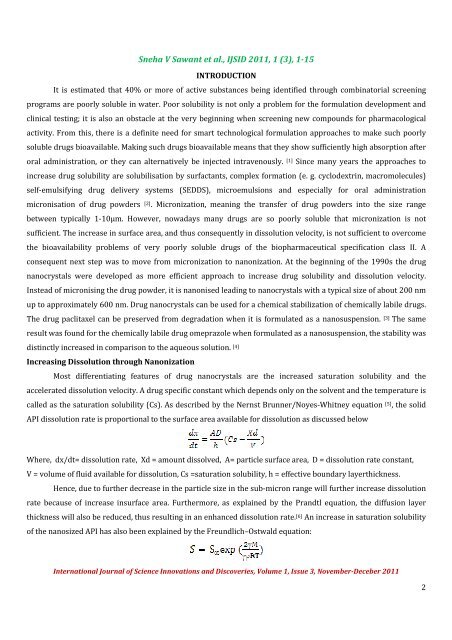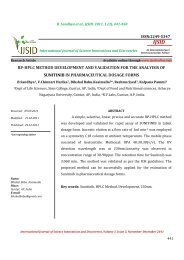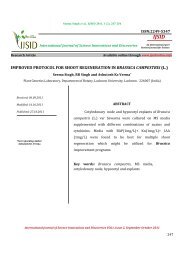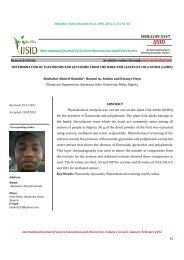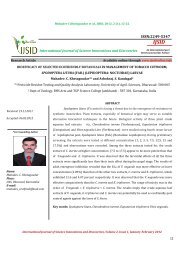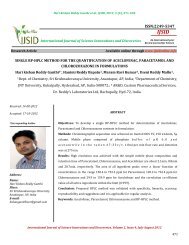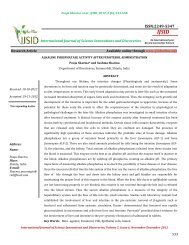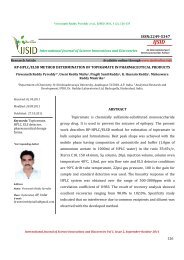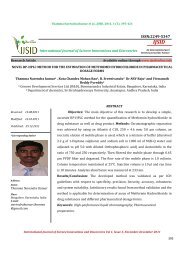drug nanocrystals: novel technique for delivery of ... - Ijsidonline.info
drug nanocrystals: novel technique for delivery of ... - Ijsidonline.info
drug nanocrystals: novel technique for delivery of ... - Ijsidonline.info
Create successful ePaper yourself
Turn your PDF publications into a flip-book with our unique Google optimized e-Paper software.
Sneha V Sawant et al., IJSID 2011, 1 (3), 1-15INTRODUCTIONIt is estimated that 40% or more <strong>of</strong> active substances being identified through combinatorial screeningprograms are poorly soluble in water. Poor solubility is not only a problem <strong>for</strong> the <strong>for</strong>mulation development andclinical testing; it is also an obstacle at the very beginning when screening new compounds <strong>for</strong> pharmacologicalactivity. From this, there is a definite need <strong>for</strong> smart technological <strong>for</strong>mulation approaches to make such poorlysoluble <strong>drug</strong>s bioavailable. Making such <strong>drug</strong>s bioavailable means that they show sufficiently high absorption afteroral administration, or they can alternatively be injected intravenously. [1] Since many years the approaches toincrease <strong>drug</strong> solubility are solubilisation by surfactants, complex <strong>for</strong>mation (e. g. cyclodextrin, macromolecules)self-emulsifying <strong>drug</strong> <strong>delivery</strong> systems (SEDDS), microemulsions and especially <strong>for</strong> oral administrationmicronisation <strong>of</strong> <strong>drug</strong> powders [2] . Micronization, meaning the transfer <strong>of</strong> <strong>drug</strong> powders into the size rangebetween typically 1-10μm. However, nowadays many <strong>drug</strong>s are so poorly soluble that micronization is notsufficient. The increase in surface area, and thus consequently in dissolution velocity, is not sufficient to overcomethe bioavailability problems <strong>of</strong> very poorly soluble <strong>drug</strong>s <strong>of</strong> the biopharmaceutical specification class II. Aconsequent next step was to move from micronization to nanonization. At the beginning <strong>of</strong> the 1990s the <strong>drug</strong><strong>nanocrystals</strong> were developed as more efficient approach to increase <strong>drug</strong> solubility and dissolution velocity.Instead <strong>of</strong> micronising the <strong>drug</strong> powder, it is nanonised leading to <strong>nanocrystals</strong> with a typical size <strong>of</strong> about 200 nmup to approximately 600 nm. Drug <strong>nanocrystals</strong> can be used <strong>for</strong> a chemical stabilization <strong>of</strong> chemically labile <strong>drug</strong>s.The <strong>drug</strong> paclitaxel can be preserved from degradation when it is <strong>for</strong>mulated as a nanosuspension. [3] The sameresult was found <strong>for</strong> the chemically labile <strong>drug</strong> omeprazole when <strong>for</strong>mulated as a nanosuspension, the stability wasdistinctly increased in comparison to the aqueous solution. [4]Increasing Dissolution through NanonizationMost differentiating features <strong>of</strong> <strong>drug</strong> <strong>nanocrystals</strong> are the increased saturation solubility and theaccelerated dissolution velocity. A <strong>drug</strong> specific constant which depends only on the solvent and the temperature iscalled as the saturation solubility (Cs). As described by the Nernst Brunner/Noyes-Whitney equation [5] , the solidAPI dissolution rate is proportional to the surface area available <strong>for</strong> dissolution as discussed belowWhere, dx/dt= dissolution rate, Xd = amount dissolved, A= particle surface area, D = dissolution rate constant,V = volume <strong>of</strong> fluid available <strong>for</strong> dissolution, Cs =saturation solubility, h = effective boundary layerthickness.Hence, due to further decrease in the particle size in the sub-micron range will further increase dissolutionrate because <strong>of</strong> increase insurface area. Furthermore, as explained by the Prandtl equation, the diffusion layerthickness will also be reduced, thus resulting in an enhanced dissolution rate. [6] An increase in saturation solubility<strong>of</strong> the nanosized API has also been explained by the Freundlich–Ostwald equation:International Journal <strong>of</strong> Science Innovations and Discoveries, Volume 1, Issue 3, November-Deceber 20112


